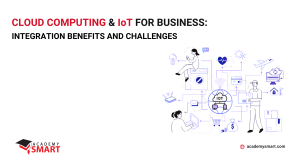Enterprise Cloud Adoption Strategy: Which Approach to Choose
Today, businesses increasingly turn to cloud computing to ensure further digital transformation and growth. The demand is apparent as organizations seek to harness the scalability, flexibility, and cost-efficiency of cloud technologies. However, choosing the right cloud adoption strategy has become a critical challenge, as it necessitates a careful balance between the practice of application migration and the development of cloud-centric, forward-looking solutions. Let’s look at modern approaches to cloud implementation plans closer.
What is Cloud Adoption Strategy
Cloud adoption strategy is a comprehensive roadmap that defines how an enterprise intends to integrate cloud computing into its current IT infrastructure and operations. It outlines the overarching approach, objectives, and principles guiding the company’s migration to and utilization of cloud services. In essence, it is a proactive measure designed to help businesses utilize cloud technologies effectively, whether that involves migrating existing systems or developing new cloud-native solutions.
A well-crafted strategy for adopting cloud technology may be crucial for several reasons:
- As companies increasingly turn to digital strategies, cloud adoption becomes a central component in enabling this transformation. Cloud technology offers the scalability, flexibility, and cost-efficiency needed to drive innovation.
- Cloud adoption can provide a competitive edge, enabling businesses to respond to customer demands and market changes faster than traditional IT infrastructure.
- A strategic approach to cloud adoption helps businesses make cost-effective decisions about resource allocation and utilization. That can result in significant cost savings, making cloud computing an attractive option.
- The strategy addresses security and compliance concerns, ensuring that data and applications are safeguarded in the cloud environment, which is crucial in a world where data protection and regulatory compliance are paramount.
- For businesses with legacy systems, it aids in planning the migration of applications to the cloud. It helps determine the best transferring approach, whether rehosting, replatforming, refactoring, or complete rebuilding from scratch.
A cloud adoption strategy is a complex plan that outlines how a company will transition to the cloud. It specifies which applications and data will be migrated, the deployment timeline, and the management approach. The strategy also aligns with common objectives, including cost reduction, enhanced agility, improved performance, quality service delivery, and innovation. Many of our clients have completed their journey to effective cloud solutions by developing and applying an adoption strategy with the assistance of Academy Smart.
Main types of Cloud Adoption Strategies
Since we have already discussed apps cloud migration in a prior blog, our focus now turns to the strategic decisions involved in creating new technical solutions. The cloud-centric approaches we delve into below are not only relevant for new developments but also for the renovation of legacy software.
Cloud-first adoption strategy
It is a compelling approach for companies aiming to harness the advantages of cloud technology as a primary choice for deploying their applications and IT solutions. This strategy prioritizes the use of cloud-based solutions over on-premises alternatives. The cloud-first adoption strategy leverages the flexibility, scalability, and cost-efficiency of cloud services, making it an attractive option for modern businesses looking to streamline their operations.
While it offers numerous benefits, businesses must carefully assess their specific requirements and potential challenges. Security, privacy, and data sovereignty may influence decisions, mainly when customer-owned and self-managed IT infrastructures are necessary. Moreover, enterprises with working legacy systems face the challenge of integrating cloud-first principles with their on-premises infrastructure. That can involve managing multiple platforms and ensuring seamless coexistence between legacy and cloud environments.
Cloud-only adoption strategy
This approach signifies a commitment to adopting the cloud as the sole solution for a company’s IT needs, often favoring public cloud offerings. It emphasizes the significance of cloud-based Infrastructure-as-a-Service (IaaS), Software-as-a-Service (SaaS), and Platform-as-a-Service (PaaS) solutions for various operational requirements. Serverless computing is a favorable choice due to its ability to offload server management, scale efficiently, and reduce costs by charging only for actual usage.
While a cloud-only strategy suits specific scenarios well, organizations should weigh potential limitations. Cloud-only solutions may offer less flexibility compared to alternatives like hybrid cloud. Enterprises, in particular, may encounter integration challenges, service availability issues, data migration complexities, and cybersecurity considerations when adopting the cloud-only model.
Cloud-native adoption strategy
This strategy centers on innovative application development practices driven by cloud technologies and principles. It is best suited for businesses seeking to exploit the full potential of cloud-native application development, focusing on innovation, automation, and agility.
Cloud-native applications are underpinned by two fundamental elements: containerization and microservices. Containerization, facilitated by technologies like Kubernetes, allows applications to be neatly packaged with all their dependencies, making them consistent, portable, and easily deployable across various environments. Microservices, on the other hand, are small, loosely coupled services that make up these applications. They are designed for distribution, resilience, manageability, and observability, promoting automation and enabling continuous integration and continuous delivery (CI/CD) pipelines. Their synergy empowers cloud-native applications with flexibility, scalability, and efficiency, making them a natural fit for the cloud environment.
This approach is convenient for new application development but may entail challenges and costs when transitioning applications to a cloud-native architecture. That is especially true for migrating existing monolithic applications into a microservices architecture. Additionally, challenges can arise when stateful applications require access to external data sources on specific cloud platforms. Solutions like data management platforms may be needed to replicate and ensure data availability across cloud environments.
Hybrid cloud adoption strategy
This versatile strategy is a pragmatic solution that combines on-premises infrastructure or private clouds with public cloud platforms like Amazon Web Services (AWS) or Microsoft Azure. It’s particularly relevant when businesses have existing data center infrastructure and seek to leverage both on-premises and cloud resources and minimize transformative risks.
This approach addresses the complexities and challenges of moving to the cloud, especially for enterprises with extensive on-premises investments. It allows organizations to gradually transition specific use cases or workloads to the cloud, starting with scenarios such as data with infrequent access, disaster recovery, or testing and development.
The primary challenge of a hybrid cloud adoption strategy is the complexity of managing data, applications, and operations across both on-premises and cloud environments while maintaining security, compliance, and cost control.
Multi-cloud adoption strategy
This method involves using multiple public cloud providers, either with or without an existing private cloud, to distribute workloads across various platforms. The strategy offers increased flexibility, reduces the risk of vendor lock-in, and enables the utilization of best-of-breed technologies from each cloud provider.
Multi-cloud adoption is appropriate when an organization seeks to diversify its cloud resources, avoid dependence on a single cloud vendor, and leverage the unique strengths of multiple platforms. Despite operational challenges, this strategy can provide functional and cost benefits, making it a popular choice among large businesses today.
What to Consider when Choosing a Cloud Adoption Strategy
When selecting a cloud adoption strategy, several critical reflections should guide the decision-making process:
- Begin by defining clear business goals for cloud adoption. Understand what you aim to achieve and how different cloud solutions may help. Create a list of technical requirements, including cloud service models, deployment models, expected workload, and preferred performance.
- Assess your current IT environment, including applications, data, and infrastructure. Identify what can be moved to the cloud and what should remain on-premises.
- Understand your security and compliance requirements. Different industries and regions may have specific regulations, and you must ensure that the chosen strategy aligns with them.
- Evaluate various cloud providers (AWS, Azure, Google Cloud) based on factors such as pricing, features, security, and compliance. Choose the platform that aligns best with your software specifications. Consider how data will be managed, stored, and transferred in that cloud. Ensure data security, backup, and recovery mechanisms are in place.
- Develop a detailed plan for migrating applications and data to the cloud. This plan should include a timeline, budget, and risk assessment. Consider challenges like vendor lock-in, data portability, cybersecurity, and scenarios to react to changing business needs.
- Address operational aspects, such as ongoing management, monitoring, and scaling of cloud resources. Ensure your development team has the necessary skills in cloud adoption and management or strategy to get the required expertise.
- Organize cost management to monitor and control cloud spending. Understand pricing models and optimize resource usage to minimize expenses.
By carefully considering these factors your cloud adoption strategy will help solve business challenges and maximize the benefits of cloud computing. Get acquainted with the case Fulfillment solution for warehouses, an excellent example of the high-quality implementation of cloud adoption plan in logistics automation applications.

Cloud-based enterprise application for warehouse automation
How Academy Smart Can Assist in Your Cloud Adoption Challenge
Our company boasts over 13 years of experience in helping clients seamlessly integrate cloud technologies into their enterprise operations. Our services encompass consulting and cloud migration, crafting native cloud applications, and engineering hybrid and multi-cloud solutions built on Amazon services.
Our team comprises highly skilled professionals with extensive expertise in programming microservices, containerization, cloud infrastructure deployment, and management. Whether you’re looking to bolster your in-house workforce with top talent or assemble a dedicated development team for a comprehensive project, we’ve got you covered.
If you’ve been contemplating the advantages of adopting cloud computing for your enterprise, get in touch today to turn those considerations into actionable solutions.
Frequently Asked Questions: Cloud Adoption Strategies
What are the benefits of cloud adoption?
Cloud adoption offers benefits such as cost savings through reduced infrastructure expenses, improved agility in scaling resources, and the ability to leverage cutting-edge technologies without heavy upfront investments.
Which cloud adoption strategy is right for my company?
The right cloud adoption strategy depends on specific business goals, current IT environment, security and compliance requirements, and the nature of your workloads. Consider cost, scalability, and application specifications to determine the approach that best aligns with your needs.


